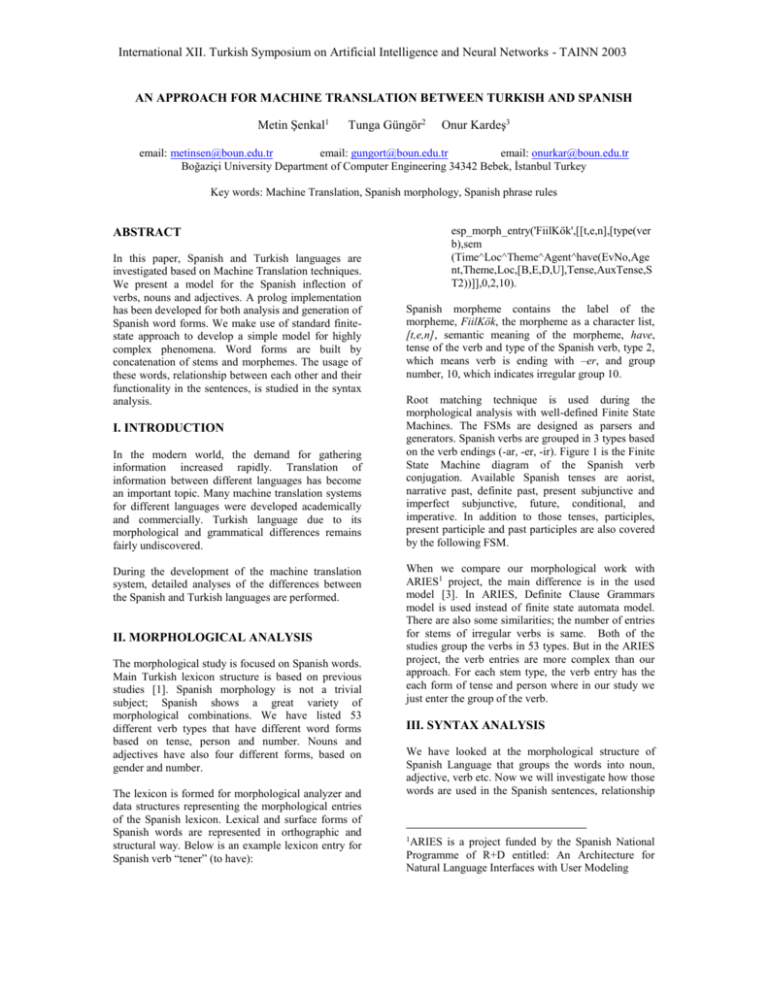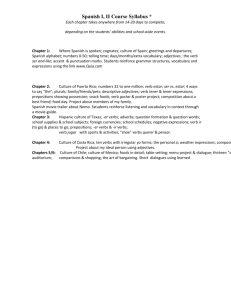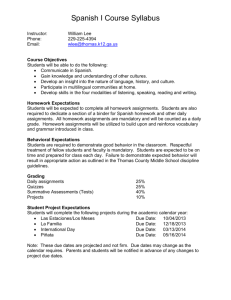MACHINE TRANSLATION BETWEEN TURKISH AND SPANISH
advertisement

International XII. Turkish Symposium on Artificial Intelligence and Neural Networks - TAINN 2003
AN APPROACH FOR MACHINE TRANSLATION BETWEEN TURKISH AND SPANISH
Metin Şenkal1
Tunga Güngör2
Onur Kardeş3
email: metinsen@boun.edu.tr
email: gungort@boun.edu.tr
email: onurkar@boun.edu.tr
Boğaziçi University Department of Computer Engineering 34342 Bebek, İstanbul Turkey
Key words: Machine Translation, Spanish morphology, Spanish phrase rules
esp_morph_entry('FiilKök',[[t,e,n],[type(ver
b),sem
(Time^Loc^Theme^Agent^have(EvNo,Age
nt,Theme,Loc,[B,E,D,U],Tense,AuxTense,S
T2))]],0,2,10).
ABSTRACT
In this paper, Spanish and Turkish languages are
investigated based on Machine Translation techniques.
We present a model for the Spanish inflection of
verbs, nouns and adjectives. A prolog implementation
has been developed for both analysis and generation of
Spanish word forms. We make use of standard finitestate approach to develop a simple model for highly
complex phenomena. Word forms are built by
concatenation of stems and morphemes. The usage of
these words, relationship between each other and their
functionality in the sentences, is studied in the syntax
analysis.
I. INTRODUCTION
In the modern world, the demand for gathering
information increased rapidly. Translation of
information between different languages has become
an important topic. Many machine translation systems
for different languages were developed academically
and commercially. Turkish language due to its
morphological and grammatical differences remains
fairly undiscovered.
During the development of the machine translation
system, detailed analyses of the differences between
the Spanish and Turkish languages are performed.
II. MORPHOLOGICAL ANALYSIS
The morphological study is focused on Spanish words.
Main Turkish lexicon structure is based on previous
studies [1]. Spanish morphology is not a trivial
subject; Spanish shows a great variety of
morphological combinations. We have listed 53
different verb types that have different word forms
based on tense, person and number. Nouns and
adjectives have also four different forms, based on
gender and number.
The lexicon is formed for morphological analyzer and
data structures representing the morphological entries
of the Spanish lexicon. Lexical and surface forms of
Spanish words are represented in orthographic and
structural way. Below is an example lexicon entry for
Spanish verb “tener” (to have):
Spanish morpheme contains the label of the
morpheme, FiilKök, the morpheme as a character list,
[t,e,n], semantic meaning of the morpheme, have,
tense of the verb and type of the Spanish verb, type 2,
which means verb is ending with –er, and group
number, 10, which indicates irregular group 10.
Root matching technique is used during the
morphological analysis with well-defined Finite State
Machines. The FSMs are designed as parsers and
generators. Spanish verbs are grouped in 3 types based
on the verb endings (-ar, -er, -ir). Figure 1 is the Finite
State Machine diagram of the Spanish verb
conjugation. Available Spanish tenses are aorist,
narrative past, definite past, present subjunctive and
imperfect subjunctive, future, conditional, and
imperative. In addition to those tenses, participles,
present participle and past participles are also covered
by the following FSM.
When we compare our morphological work with
ARIES1 project, the main difference is in the used
model [3]. In ARIES, Definite Clause Grammars
model is used instead of finite state automata model.
There are also some similarities; the number of entries
for stems of irregular verbs is same. Both of the
studies group the verbs in 53 types. But in the ARIES
project, the verb entries are more complex than our
approach. For each stem type, the verb entry has the
each form of tense and person where in our study we
just enter the group of the verb.
III. SYNTAX ANALYSIS
We have looked at the morphological structure of
Spanish Language that groups the words into noun,
adjective, verb etc. Now we will investigate how those
words are used in the Spanish sentences, relationship
1ARIES
is a project funded by the Spanish National
Programme of R+D entitled: An Architecture for
Natural Language Interfaces with User Modeling
International XII. Turkish Symposium on Artificial Intelligence and Neural Networks - TAINN 2003
between each other and their functionality in the
sentences.
The lexicons represent most of the Turkish and
Spanish syntactic categories, mainly nouns, proper
nouns, pronouns, adjectives, conjunctions, verbs, and
temporal adverbs. Turkish phrase structure rules are
defined in previous studies [1,2]. Spanish phrase
structure rules are defined for syntactic analysis. Table
1 lists the phrase structural rules for Spanish nouns
and verbs.
S
S
S
Svocative
NPsubject
NPsubject
NPsubject
NPnominative
NPcomplement
NPcomplement
NPgenitive
NPacusative
NPdative
NPdative
NPablative
NPvocative
VPnominal
VPverbal
VPverbal
VPverbal
VPverbal
VPverbal
VPverbal
VPverbal
VPtransitive
VPtransitive
NPsubject
NPsubject
VPverbal
NPvocative
NPnominative
PR
NPcomplement
N
NPcomplement
D
PREPde
PREPa
PREPa
PREPpara
PREP
Ncomma
VPauxiliary
VPtransitive
VPtransitive
VPtransitive
V
V
V
Vimperative
VPprep_a
VPno_prep_a
VPverbal
VPnominal
S
An example of nominal predicate:
Ese es Juan. (That is Juan)
(S NPsubject VPnominal where NPsubject PR and
VPnominal VPauxiliary NPnominative)
The subject and the predicate must be number
harmony. If the subject is singular then the predicate
must be same or if the predicate is plural then the
subject must be same, too. Below are the sample
person suffixes that are taken from source code of our
prolog prototype:
esp_morph_entry('1.tek',[[],[per(1),num(sing)]],MV,
Type,Group).
esp_morph_entry('2.tek',[[s],[per(2),num(sing)]],MV,
Type,Group).
esp_morph_entry('3.tek',[[],[per(3),num(sing)]],MV,
Type,Group).
esp_morph_entry('1.çog',[[m,o,s],[per(1),num(plur)]],
MV,Type,Group).
esp_morph_entry('2.çog',[[i,s],[per(2),num(plur)]],MV
,Type,Group).
esp_morph_entry('3.çog',[[n],[per(3),num(plur)]],MV,
Type,Group).
NPgenitive
N
N
N
N
N
N
NPnominative
NPacusative
NPdative
NPacusative
NPcomplement
NPablative
predicates can be adjective, noun, pronoun, adverb or
a phrase in the sentence, and they are used with
auxiliary verbs, SER and ESTAR.
The person per(1) and number num(sing) must be
same for predicate and subject.
NPdative
The verbs not only express the action, but also they
provide the time (tense suffixes) and the type of the
subject (personal suffixes). For this reason, for the 1 st
and 2nd person (I and You) the subject is not used in
the sentence.
NPcomplement
Table 1. Sample Spanish Noun and Verb Phrase Rules
Main elements of a Spanish sentence are subject and
predicate. The subject is the element that does the
action, which is stated by the predicate in the sentence.
The subject is not necessarily made up of nouns; it can
be also adjective, pronoun, adverb, phrase or another
sentence.
An example of noun subject:
Juan duerme. (Juan sleeps)
(S NPsubject VPverbal where NPsubject NPnominative
and VPverbal V)
The predicates are two types, the verbal and the
nominal ones. The verbal predicates express the
motion or the action, which is done by the subject. In
the above example, the predicate duerme is verbal.
The nominal predicates do not express an action rather
they convey a property of the subject. The nominal
An example of a sentence where the subject (I) is
missing:
Escribo una carta. ( [I am] writing a letter)
(S VPverbal where VPverbal V NPcomplement and
NPcomplement D N)
We have already seen the main elements of the
sentence, subject and predicate. When these elements
exist in a sentence, that sentence is grammatically
correct. But sometimes those main elements do not
form a meaningful sentence, we need to explain,
determine and complete these elements. This is done
by complements in a sentence. There are three types of
complements; complements that complete the subject,
complements
that
complete
the
predicate,
complements that complete other complements.
We have already listed different types of subjects in
our examples. So the complements of subjects vary
according to the type of subject. Mostly used
complements of subjects are noun, pronoun and
infinitive.
International XII. Turkish Symposium on Artificial Intelligence and Neural Networks - TAINN 2003
We have listed two possible predicates of a sentence;
either verbal predicates or the nominal predicates
(with the help of auxiliary verbs). When a nominal
predicate is a noun, the complement can be a
determiner, an adjective or a noun phrase.
There are various types of verbs in sentences; verbs
are the most diverse elements of a sentence. So there
are numerous complements of verbal predicates. The
complements of verbal predicates are grouped in three
classes, The Direct Complements, The Indirect
Complements and The Circumstantial Complements.
The complements can be noun, pronoun, infinitive,
participle or auxiliary sentence.
The words that are directly affected by the subject are
the direct complements. In general the direct
complements are used without preposition and directly
connected to predicates. The verbs that can take direct
complements are transitive verbs. The indirect
complements show the action is done for whom and
why in a sentence.
Other than direct and indirect complements, there are
complements that complete the verb with the
meanings such as location, time, duration, instrument,
condition etc. This kind of complements are used with
prepositions such as to, from, in, by, etc. or without
prepositions but still answers the questions where,
when, how, how much/many, with whom, why.
Examples of various complements:
La criada trajo el abrigo de Juan. (The servant brings
the Juan’s coat)
(S NPsubject VPverbal where NPsubject NPcomplement
and VPverbal V NPcomplement and NPcomplement
NPcomplement NPgenitive)
Mi madre ha visto a Juan. (My mother has seen Juan)
(S NPsubject VPverbal where NPsubject NPcomplement
and VPverbal VPtransitive NPacusative where VPtransitive
VPprep_a)
It is possible that the complements themselves can be
completed by other complements. Those kinds of
complements generally consist of nouns or adjectives.
La noticia de la llegada del presidente fue recibida con
gritos de alegría.
(The news of the arrival of the president was received
with joy shouts.)
‘La noticia’ is the subject of the above sentence. ‘de la
llegada’ is the complement of the subject. And ‘del
presidente’ is the complement of complement. It
completes the complement ‘de la llegada’. Besides
that, the predicate is ‘fue recibida’ is completed by
‘con gritos’ and the complement ‘con gritos’ is also
completed by ‘de alegría’, which is also a complement
of a complement.
IV. CONCLUSION
In this paper, we have presented a plain finite-state
automata based model for the Spanish inflection of
verbs, nouns and adjectives. Spanish verb conjugation
with a great variety of morphological combinations is
implemented in Prolog. We take the advantage of
bidirectionality of Prolog during analysis and
generation phases of the program.
After morphological analysis, the words that are
grouped in noun, adjective, verb are investigated
according to their functionality in the sentences.
Spanish phrase structure rules are defined for syntactic
analysis.
The study on Spanish semantic representation of a
sentence in the knowledge base is in progress. As a
future work, the semantic rules will define how the
scope of the sentence will be derived. Introduction of a
Spanish to Turkish MT system with a limited amount
of semantic analysis will be helpful for later
researches.
REFERENCES
La mujer ha dado una limosna. (The woman has given
some alms)
(S NPsubject VPverbal where NPsubject NPcomplement
and VPverbal VPtransitive NPacusative where VPtransitive
VPno_prep_a)
1.
Mi padre ha traído un libro a Juan. (My father has
brought a book to Juan)
(S NPsubject VPverbal where NPsubject NPcomplement
and VPverbal VPtransitive NPacusative NPdative where
VPtransitive VPno_prep_a)
3.
Juan, ven aquí! (Juan, come here!)
(Svocative NPvocative S where S Vimperative
NPcomplement)
2.
Ö. Çetinoğlu, “A Prolog Based Natural Language
Processing Infrastructure for Turkish”, M.S.
Theses, Boğaziçi University, 2001.
O. Kardeş, “Semantic Formalization of Turkish
Text in an Application Area”, M.S. Theses,
Boğaziçi University, 2002.
A. Moreno and J.M. Goñi, “GRAMPAL: A
Morphological
Processor
for
Spanish
implemented in Prolog”, 1995 Joint Conference
on
Declarative
Programming
(GULPPRODE’95), Marina di Vietri (Salerno, Italy),
1995.









